


[Bundesarchiv, Bild 146III-373 / CC-BY-SA 3.0, CC BY-SA 3.0 de, via Wikimedia Commons]
In his Essay on Kitsch and Death, historian Saul Friedländer suggests that the persuasive power of Nazism was less derived from explicit ideology, rather than the power of emotions, images and phantasms. Friedländer refers to the presence of an unknown factor which has not been addressed by research. Though the architectural products of Nazi ideology are the subject of many research works, still the unknown factor for fascination with these “mighty works” has yet been fully theorized.
In this paper, I ask to use the term sublime as a philosophical framework for an interpretive reading of Nazi architecture and its modern and ideological aspects. For the purpose of this discussion, I examine how the sublime is manifested in Welthauptstadt Germania - the mostly unrealized urban plan of Berlin’s city center, devised by Hitler and architect Albert Speer in the years 1933-1939.
The paper explores specific expressions of the sublime in Nazi architecture, which exceed quantitative descriptions and also regard the cornerstones of the socio-symbolic order. As will be shown, the sublime is found in all aspects of Nazi architecture and is inseparably linked with its modernity.
In In his Essay on Kitsch and Death, historian Saul Friedländer suggests that the persuasive power of Nazism was less derived from explicit ideology, rather than the power of emotions, images and phantasms.[2] Nazism’s distinguishing quality lies in its psychological dimension and its hypnotic influence over so many people. That quality cannot be fully theorized by historiography stemming from political, socio-economic and cultural explanations. Friedländer refers to the presence of an unknown factor which has not been addressed by research.[3]
Though the architectural products of Nazi ideology are the subject of many research works, still the unknown factor for fascination with these “mighty works” has yet been fully theorized. Borrowing from Hitler’s wording, I would like to refer to this factor as the “sublime”. In this paper, I ask to use the term sublime as a philosophical framework for an interpretive reading of Nazi architecture[4] and its modern and ideological aspects. For the purpose of this discussion, I will examine how the sublime is manifested in Welthauptstadt Germania - the mostly unrealized urban plan of Berlin’s city center, devised by Hitler and architect Albert Speer in the years 1933-1939.
1. On the Sublime
The sublime refers to infinite or absolute greatness which is beyond perception and cannot be represented in form or language. Spatial, temporal, and conceptual characteristics of the sublime have furnished its importance in aesthetic theory and praxis since the 18th century.
Immanuel Kant and Edmund Burke were first to articulate the dialectics of the sublime and the beautiful, which stood at the center of aesthetic discourse of that time. Burke emphasized the sensual-material aspect of aesthetic appreciation, while Kant focused on its subjectivity as well as its universality – “a representation of limitlessness, yet with a super-added thought of its totality”[5]. Both applied the sublime on the relations between man and nature, addressing its alluring yet intimidating qualities – “whatever is in any sort terrible”[6].
In the 18th and 19th centuries Burke and John Ruskin both formulated criteria for achieving sublimity in architecture, including monumentality, scale manipulation, multiplicity, infinity and light (or lack thereof). These physical criteria were followed in the 20th century by additional criteria involving emotional responses to architecture.
Sublime discourse renewed in the late 1970’s in the context of critique of modernity. Poststructuralism re-incorporated the sublime into aesthetics, led by Jean François Lyotard who declared it “the single artistic sensibility to characterize the Modern”[7]. Jacques Lacan incorporated the sublime into psychoanalysis via the sublime object, a term referring to negative representation of a lack. This concept was later taken up by Slavoj Žižek, in his critique of ideology.
In architecture theory, Anthony Vidler and others called attention to the 18th-century ‘architects of the sublime’ – Claude Nicolas Ledoux and Étienne-Louis Boullée. Later on, Vidler articulated the Architectural Uncanny, inspired by Freud’s uncanny - the frightening aspect of the sublime, referring the alienated presence of something once familiar that has been repressed. The Architectural uncanny stems from modern architecture’s tendency for alienation, anxiety and fear of disintegration of the body.[8]
Another notion of sublime is the technological sublime, replacing the romantic relations between man and nature with the modern relations between man and the machine, or the postmodern relations between man and global-network technology (see Frederic Jameson, Perry Miller, David Nye et al).
While theoretical discourse has referred to the sublime in regards with modern art, technology and architecture, there has hardly been any discussion on the sublime in fascist architecture. For this reason, I ask to offer another perspective on Nazi architecture via the sublime. Let us, then, take a short excursion into Nazi aesthetics, in the form of a stroll down the grand boulevard of Welthauptstadt Germania.
2. What’s Between Welthauptstadt Germania and Modernism?
Welthauptstadt Germania, meaning “World Capital Germania”, offered a new urban layout to Berlin’s city center. The plan, initiated by Hitler and executed by his architect and Minister of Armaments and War Production Speer [9], is a paradigm of modern urban planning that uses aesthetic means for ideological purposes. The plan was comprised mainly of a 5-kilometer-long boulevard, 120 meters in width, along which were placed consecutive large-scale megastructures [fig.1]. These were meant to form the governmental, financial, cultural and social center of the Reich’s capital. According to the planners’ vision, visitors to the new city would have landed at Tempelhof Airport, and within a short walking distance arrived at the grand boulevard - where they would have witnessed the greatness of Nazi rule in an architectural display unprecedented in its urban scale. Historian Steven Helmer suggests that Speer engaged not in urban planning, but in planning a giant exhibition hall or a theatre stage for the German captive audience.[10]
At both ends of the boulevard were placed the most noticeable monuments – north was the Great Hall (Volkshalle), a pantheon topped by a gigantic dome, 250-meter in diameter; and south was a 117-meter-high Triumphal Arch, supposed to compete with the Parisian arch.[11] Two thirds of the boulevard were assigned for leisure uses –theatres, an opera house, concert and congress halls, a hotel, stores and restaurants. The surrounding urban blocks were smaller in scale and designated for offices and commerce. Further along were planned smaller residential blocks.[12]
Nazism called for the renewal of Germanic-Volk culture and the perception of the people as a community (Völkisch), in order to eliminate social stratification (Volksgemeinschaft). For that purpose, colossal versions of the ‘people’s house’ assembly halls (Volkshaus) were erected in German towns. Such was the Great Hall, designed to contain 160,000 people during public gatherings [fig.2].
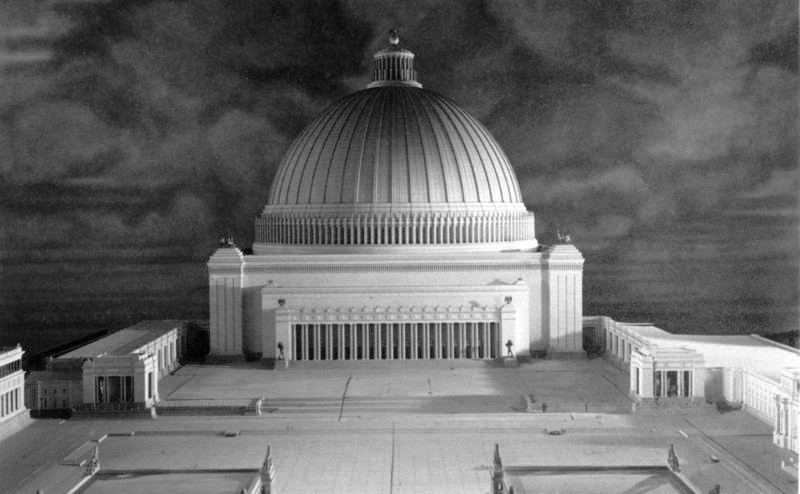
[Bundesarchiv, Bild 146-1986-029-02 / CC-BY-SA 3.0, CC BY-SA 3.0 de, via Wikimedia Commons]
Welthauptstadt Germania was a prototype masterplan for all large German cities. Each city was to have a wide parade boulevard, an assembly hall, a bell tower and party institutions.[13] In-spite of comprehensive planning, almost none of the buildings planned for Berlin were ever built. Planning commenced with Hitler’s rise to power, and the architectural, urban and ideological characteristics of Welthauptstadt Germania were defined in detail. Extensive preparations for execution were made before and during WWII, but came to a halt by 1940. Among only four buildings that were completed, two remain today – Tempelhof Airport and the Ministry of Aviation building (currently housing the Ministry of Finance) [fig. 3,4].

[Photograph by author]
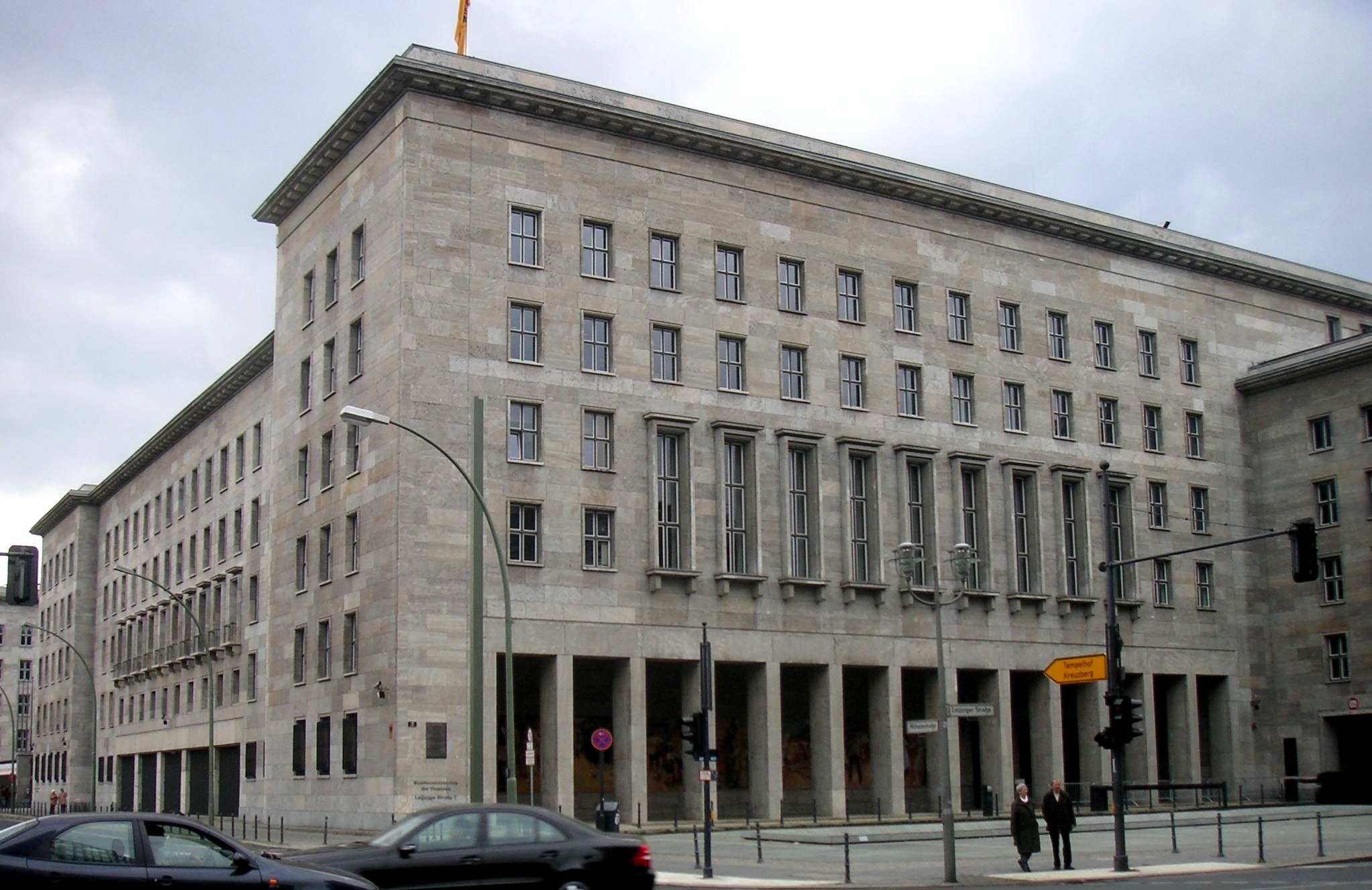
[Peter Kuley / CC BY-SA 2.5, via Wikimedia Commons]
The architectural style designated by the Third Reich for the public sphere was a combination of 19th-century neoclassicism and Volk-romantic design. Architectural historiography till mid-20th century did not classify architecture of totalitarian regimes as modern, since it lacked in innovation and its monumentality was considered antithesis to modernity.[14] Nevertheless, later examination of Nazi architecture has revealed distinct modern characteristics: technological and functional innovation, use of industrialized building materials, and efficient bureaucracy – monumental construction erected rapidly. Nazi buildings wore an old ‘costume’ of stone and marble, covering steel frames and concrete beams.
Historian Jeffery Herf presents the dialectical approach of the Third Reich toward modernism in the term Reactionary Modernism - sanctification of modern technology and progress, while dismissing the liberal values of the Enlightenment.[15] Following opposing standpoints, I contend that Nazi architecture was not only a reaction, but the direct outcome of cultural, sociological, technological and aesthetic processes of the Enlightenment. One aesthetic process promoted by Nazi architecture was the introduction of aesthetics into political life.
3. Aestheticization of Politics
In The Work of Art in the Age of Mechanical Reproduction, Walter Benjamin argues that the perception of architecture is more tactile than optical – appropriated by touch, accomplished by habit and consummated in state of distraction, so it would easily incite the masses at turning points of history. In light of these qualities, architecture was the ideal instrument for “the introduction of aesthetics into political life” by fascism, as Benjamin puts it.[17]
Hitler saw in architecture an important tool of propaganda. The organized public gathering in a structure such as the Great Hall made an individual a part of a group, by what he called ‘suggestion of the masses’.[18] Therefore, Hitler organized the masses in various spaces – stadiums, halls and parades – which transformed the shapeless masses into Volk.[19]
The metropolitan masses, captive of all-encompassing architecture, would become alienated of their individuality. Best put by Speer – “as soon as they, […] stepped out of the station they would be overwhelmed, or rather stunned, by the urban scene and thus the power of the Reich”.[20]
Modern age is perceived as an age of trauma, when man is subjected to physical shock, followed by suppression of physical reality. To Friedländer, the corner-stone of Nazi aesthetics is the combination of contradicting imagery of oppression with apocalyptic visions, which has a paralyzing effect on the senses. This allows the unbearable reality to be scaled down to a tolerable social conduct that forms the social infrastructure.[21] Thus, at the core of aestheticization there is a numbness of the senses, performing as an anesthetic and allowing humanity to relish in its destruction.
4. Expressions of the Modern Sublime in Nazi Architecture
4.1 The Sublime in Nazi Discourse
Though absent from scholarly research on architecture, the concept of the sublime was clearly present in Nazi discourse. Nazi life philosophy adopted Kantian aesthetics as evidence of the intellectual supremacy of German culture. Philosopher Ludwig Klages proclaimed that modern man had alienated himself from life. He who experiences life doesn’t think, want or act, he is ‘enchanted’, ‘overwhelmed’, ‘fascinated’, ‘shocked’, ‘surrendered’ by life. Klages is using the 18th-century rhetoric of the sublime, and according to historian Boaz Neumann it was that kind of life experience that Nazis wanted to go back to.[22]
The implementation of common philosophical conceptions in politics was a Nazi novelty. In its Nazi adaptation, the sublime became an object one succumbs to and was often used in relation to major political figures, especially the Führer.[23]
Returning to the opening quote of this paper – at the Nazi Party General Assembly in 1937 Hitler describes the intent behind the buildings of Welthauptstadt Germania, which would “provide the most sublime evidence of the political strength of the German nation”. His use of the sublime is dialectical - on the one hand, it evokes aesthetic pleasure, wonder and aw in the presence of the gigantic, mighty and limitless; on the other hand, those exact qualities evoke fear and terror. Modern conception of the sublime can be found also, in appealing to the collective and individual unconscious. Hitler claims that the giant buildings would fill the Germans with limitless self-confidence, when in fact they were intended to do the opposite – to alienate the individuals from themselves and their environment. In what architectural-sublime means can that manipulation be achieved?
4.2 Architectonic Manipulation of the Sublime
As mentioned, Burke and Ruskin defined criteria for achieving sublimity in architecture that included physical and spatial qualities. Vidler added psychological criteria, involving the emotional response to architecture. In common with these approaches is the use of illusions, evoking discomfort or terror. As phantasms were key element in Nazi aesthetics, the use of sublime aesthetics in architecture matched the aspiration to unify the Volk under Nazism. I would like to point out five elements – concrete and conceptual – as the primary means of manipulation which is achieved by the sublime in Welthauptstadt Germania:
A. The Artificial Infinite
A distinct characteristic of totalitarian urban planning (but not exclusive to totalitarianism), is the infinite axis. This is the embodiment of what Burke called the “artificial infinite” - “the eye not being able to perceive the bounds of many things”, producing the effect of infinity.[24] The infinite axis is a leitmotif of modernism – the myth of autogenesis, of modern man creating himself and his world. In early 20th century, autogenesis manifested in an unprecedented scale of urban planning. Much like Berlin’s grand boulevard - a main axis one cannot see the end-of, though less ambitious, Benito Mussolini planned the Esposizione Universale di Roma in the outskirts of Rome in 1938-42; in 1935 the Gran Via was planned in Madrid; and Moscow was re-designed as the Capital of Socialism. The infinite axis did not skip democracies, as the length of Washington’s National Mall (1901) is 3.1 kilometers, compared with the 5 kilometers of Berlin’s boulevard.
Modern urbanism’s pretension was to build cities without memories. Modernists such as Le-Corbusier and Bruno Taut wanted to erase the monuments of the traditional city since they were agents of memory, and proposed grandiose utopian city plans. Speer’s plan was less ambitious, yet it combined the motif of autogenesis with the traditional conception of the city full of monuments. Moreover, it went beyond utopia and achieved concrete realization.
The image of infinity in the urban scale repeated itself in all levels of planning, down to the single building. For instance, the total length of Tempelhof Airport is 1.3 kilometers, and even today it remains one of the longest buildings in the world. The sense of infinity is intensified by the building’s radial shape, making it impossible to see its end. [fig.5]
[USAF / Public domain]
B. Monumentality and Repetitiveness
The main novelty in Speer’s plan was its scale. The limits of proportion which guided neo-classical architecture were broken, with each building in Welthauptstadt Germania being as large as an entire city block of historic Berlin [fig.1]. Since the plan was applied on a built urban fabric, an extensive demolition project was needed. Speer acknowledged that the Great Hall and Grand Arch would have completely distorted the city’s architectural proportions.[25]
Hitler and Speer aspired for buildings which would stand for a thousand years, and even when demolished would retain their status of monuments. Speer also admitted they took inspiration from Ledoux and Boulée [fig.2,6].[26] On Hitler’s tendency for exaggeration Speer remarks: “He wanted the biggest of everything to glorify his works and magnify his pride.”[27] On another instance, Speer denies the exaggeration and claims the buildings were not excessive in comparison with skyscrapers and public buildings of the 1960’s. Possibly, it was not their size but their pretension that made them “abnormal”.[28]
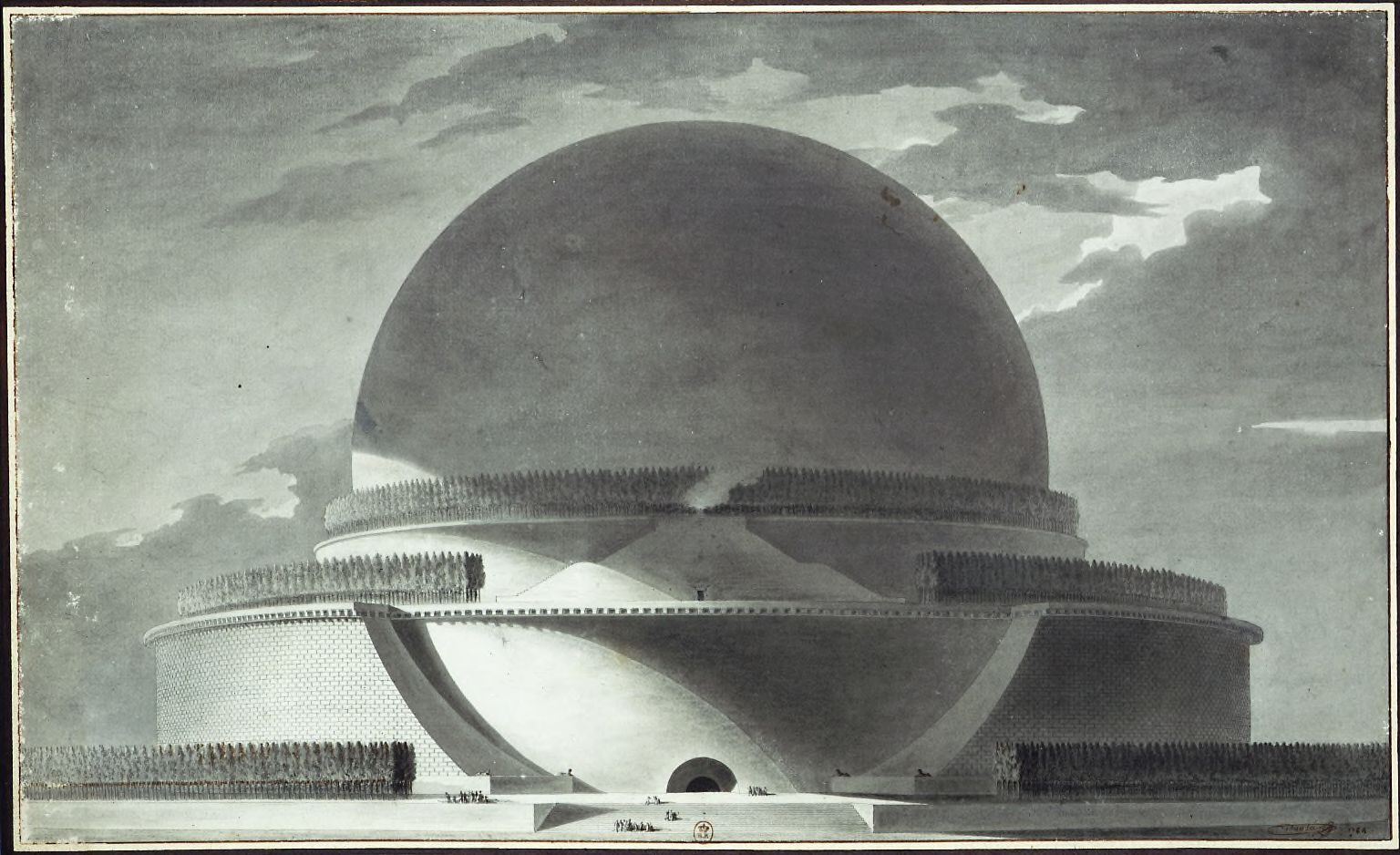
[Étienne-Louis Boullée / Public domain]
There was uniformity in plan and rhythm amongst all buildings along the Grand Boulevard. Since the erection of skyscrapers was not allowed, buildings were planned in spans of 150-180 meters, along which the architectural elements repeated monotonously. Hitler declared that propaganda must focus on little and repeat it endlessly. Only thousands of repetitions on the simplest terms would penetrate the memory of the masses.[29] The buildings of the city could also be considered a form of speech - accentuating content by repetition (rows of columns/windows/entire façades), often use of slogans (Greek-Dori columns, multitude of eagle sculptures and swastikas), a shouting tone of voice (the height of the Great Hall, the width of the boulevard).
The use of repeating elements and the motif of eternity are effective tools of hypnosis by repetition. The sensual overflow caused by the architecture is followed by a perceptual failure. The image stored in the collective memory of the people is the same repeating image.
Nazi buildings, supposed to lose their aura as a result of reproduction, still retained it due to their monumentality. Size in itself transformed the buildings into empty symbols, loaded with meaning. This is reflected in Speer’s words:
C. The Question of Scale or: The Nazi Phantasmagoria
Phantasmagoric constellations are illusionary representations of reality through technical manipulation of the senses. Phantasmagoria, in its totality, assumes the position of objective truth. By means of monumentality, repetition, scale manipulations and the illusion of infinity, Nazi urban space would have become a total alternate reality to historic Berlin.
The Nazi phantasmagoria is best exemplified in one of Tempelhof’s façade segments. The façade is composed by repeating segments appearing in regular intervals. The entire curved façade can only be seen from a distant bird’s-eye view. Since there is not enough distance to allow full perception from beginning to end, the sense of totality is intensified. [fig.7,8]
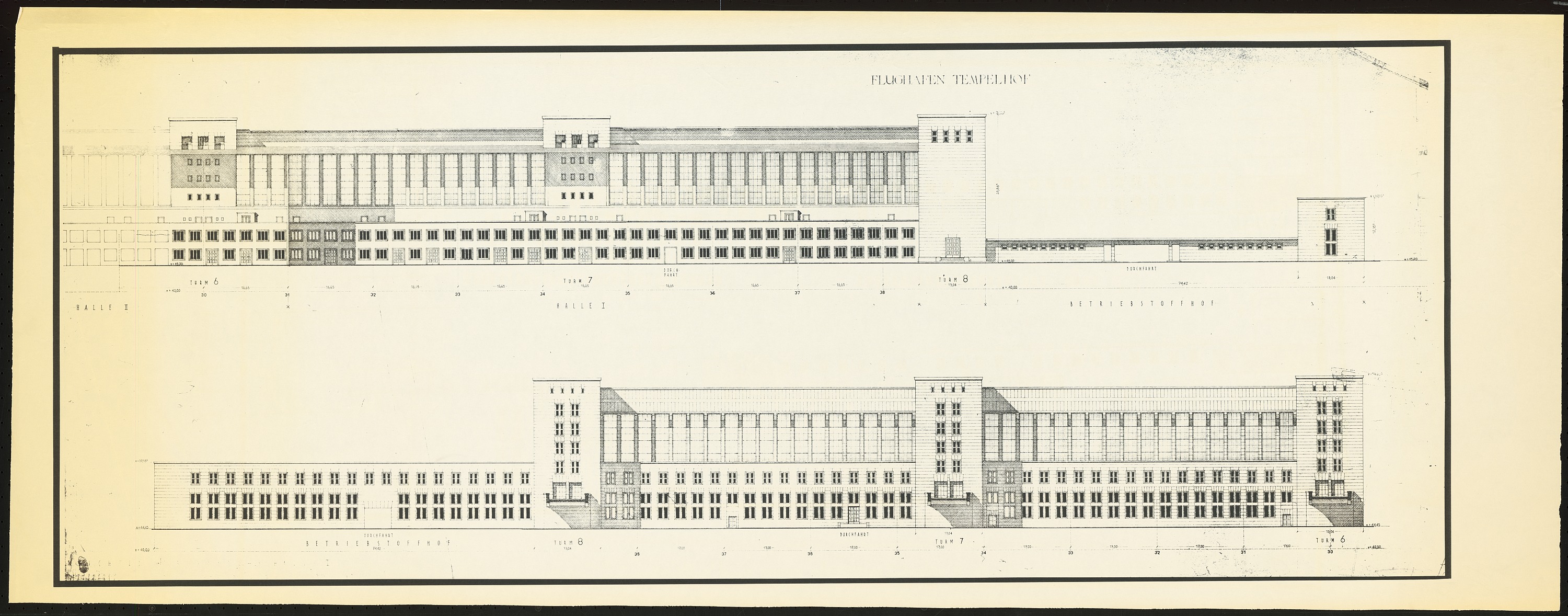
[Architekturmuseum der Technischen Universität Berlin in der Universitätsbibliothek]

[Photograph by author]
Moreover, the size of the architectural elements composing the façade exceeds their common function. When isolating a random segment with no external size reference, one can mistakably think that the size of a man in relation to the building would be as on the left side of fig.9. The actual size of a man in relation to the building is as on the right side. Human scale ceases to provide any reference for the size of the architectural element, and scale - in itself a relative term - becomes irrelevant and unmeasurable. The phantasmagoria sets a contingent point of reference in a total reality.
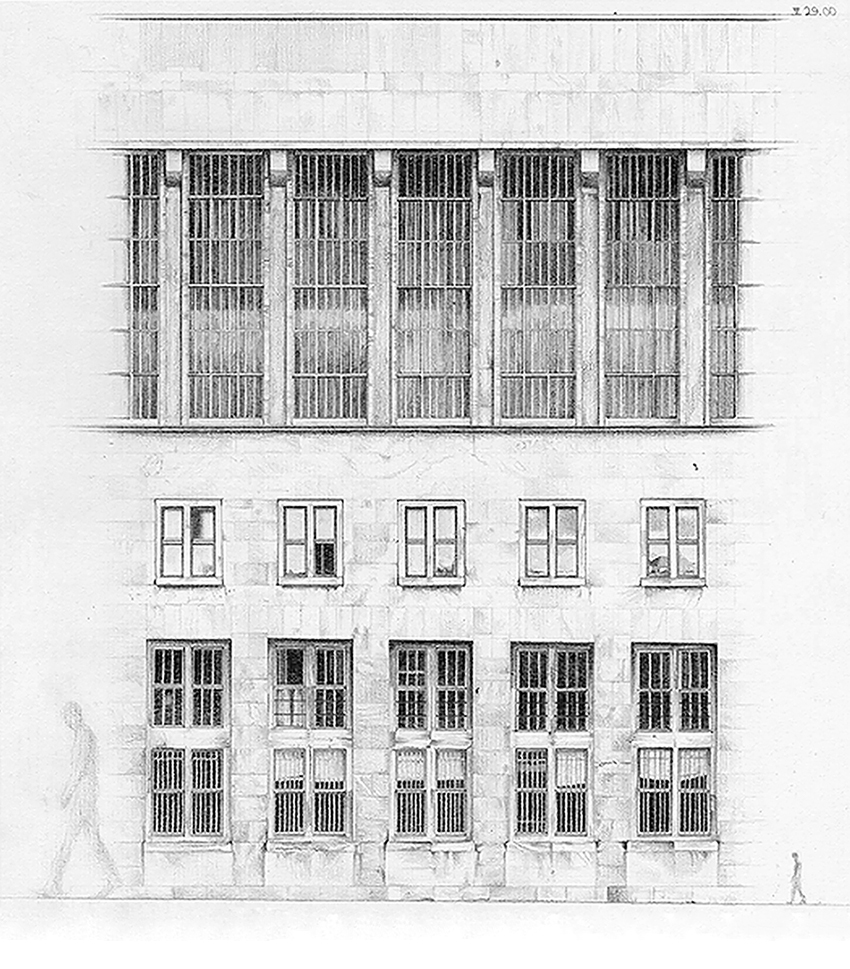
[Drawing by author]
D. The Flâneur in Nazi Berlin
The Return of the Flâneur (1929) is a review Benjamin wrote on Franz Hessel’s book Walking in Berlin, in which he described the experience of strolling in Berlin. The Flâneur – a figure of a stroller Benjamin had borrowed from Baudelaire - walks the streets aimlessly and traces the landscape of everyday city life. Unlike the rushed walk of the city crowd, the flâneur walks subversively in a slow pace, challenging the fast rhythm of modern urban life.[31] However, Berlin was never as populated metropolis as Paris or London, and its streets were never crowded. Berlin does not possess the physical or cultural qualities for wandering, which does not come naturally for Berliners. The flâneur evokes their suspicion.[32]
The flâneur that Benjamin describes with excitement in 1929 is Berlin’s daydreamer, who ultimately loses his space of flânerie in Hitler’s 1933 drawings. Strolling down the Grand Boulevard, his shock reaction to the phantasmagoric totality would transform the flâneur into the man of the crowd. In that anesthetic state phantasm would become his reality, thus the flâneur would succumb to ideology.
E. (Light as Matter)
In a party rally held at Tempelhof in 1933, Speer first conceived the ‘Cathedral of Light’ (Lichdom) – using light as matter via vertical columns of light, created by projectors placed on a stage facing upwards. Although that kind of use of light was never realized in Welthauptstadt Germania, it could be presumed that Speer had intended to recreate the iconic Cathedral of Light created in the Zeppelinfeld of Nuremberg. On the 1936 Reich Party Day Speer lit the Zeppelinfeld at a night rally using 130 anti-aircraft searchlights, each with a 2-meter radius, facing the sky [fig.10].[33]
When recalling the rally, Speer describes the elements required for enchantment with the Nazi sublime:
Appearance, a monumental effect of height, depth and size and a mass of light - all are of course a phantasm of no less than a cathedral, emerging from the darkness. The cathedral of light is considered a highlight in the process of aestheticization of Nazi political space.
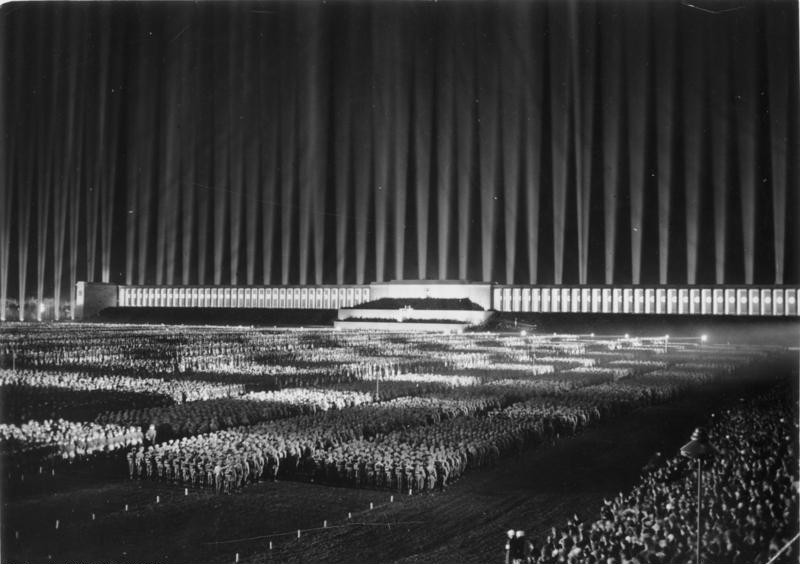
[Bundesarchiv, Bild 183-1982-1130-502 / CC-BY-SA 3.0 [CC BY-SA 3.0 de], via Wikimedia Commons
5. The Sublime Object of Nazi Architecture
Having mapped the architectural manipulations of the Nazi sublime in their historic context, let us now focus on what lies in the kernel of Nazi architecture. In other words, let’s examine how a Nazi building functions as a sublime object a-la-Lacan and Žižek.
5.1 The ‘Ideological Quilting’ of a Building
A building assumes the position of a sublime object, following Lacanian logic, when raised to the level of the Thing – a Freudian term referring to a traumatic kernel which resists representation, yet its existence allows representation to occur.[35] The objects chosen to represent what is beyond representation become alluring yet intimidating, and hence sublime.
Žižek describes the sublime object as an object with “a massive, oppressive material presence; it is not an indifferent void […], but at the same time it does not circulate between the subjects”[36] The material excess compensates for a structured absence. Once approaching the sublime object too closely, it loses its sublimity and becomes an ordinary everyday object, because its sublimity is not intrinsic, but an outcome of its structural place in the symbolic order. The intent in grasping what is at the kernel of the phenomenon, is to get close enough to it that it would lose its enchanting power.[37]
Tempelhof airport exemplifies a building that performs as a sublime object. In order to achieve symbolic identification with the Nazi social order, spatial manipulations were required – the illusion of infinity, monumentality, repetition, phantasmagoric totality and perceptual failure. Moreover, the neoclassical style associated the airport compound with Nazi architecture.
The moment in which symbolic meaning is fixed is defined by Lacan as the point de capiton (nodal point) – the point at which the signifier and signified are quilted together.[38] Žižek presents the formation of ideological space as an assembly of signifiers whose identity is not pre-determined, but sewn together into a fixed meaning in the process of ‘ideological quilting’.[39] For instance, Liberal ideology ‘quilts’ the neoclassical architectural style into public buildings that represent the republic, or the largest democracy in the world. Fascist ideology, on the other hand, ‘quilts’ Neoclassicism to buildings that represent subordination of the public to the leader.
What gives Tempelhof its symbolic meaning then, beyond its descriptive qualities, is its ‘quilting’ into Nazism. Following that logic, ‘quilting’ to another ideological field could potentially give it a different meaning. This is exemplified in Tempelhof’s recent function as temporary shelter for refugees. The building, as a sublime object, is charged with excessive symbolic meaning, while it is not pre-dispositioned toward a specific ideology, but only toward ideology as such, mainly because of its size.
The point de capiton which gives Tempelhof its meaning is but the embodiment of a lack at the heart of representation, which the sublime object needs to compensate for. Tempelhof’s architectural features nicely illustrate this point: the radial elongated building could be regarded as sort of medieval ‘city wall’; the enormous building, surrounded by the city from one side, conceals the fact that there is nothing behind it [fig.5].The empty field in the midst of the city is the void within representation, and it is disguised by the sublime object.
5.2 The Fantastic City: A Structure of Interpellation
Žižek defines ideology as a social fantasy “which is possible only on condition that the individuals partaking in it are not aware of its proper logic.”[40] The role of the fantasy is to paint a coherent picture of a homogeneous society, while there is no such society. The fantasy is not located in social theory but in material reality, in the form of an illusory structure.[41] The illusionary structure of the Nazi City is built on repetition. Following Hegel’s concept of historic repetition, if a monumental building such as the Great Hall raptures Berlin’s historic city, it is experienced as trauma in the urban fabric. But if the monumental presence appears repeatedly along the Grand Boulevard, it acquires a symbolic value and is experienced as part of a cohesive urban layout. Each element receives its meaning retroactively through repetition, and the illusion is that meaning was there a-priori.
The sublime objects in the image of Welthauptstadt Germania’s buildings are a device of interpellation of the German people, it is where they are integrated into the new socio-symbolic order. The Nazi phantasmagoria forms the fantastic structure – the reality through which the subjects experience the world as consistent and meaningful and escape trauma.
The unification of society – through volkism, through the united appearance of the material space, by establishing a city as the ultimate place for public gathering – is an ideological fantasy. Through urban design, the structured lack within the social order receives positive materialization. The role of the critique of ideology according to Žižek, is to locate those sublime objects - with their fascinating presence - within ideology, and to recognize them as placeholders in the symbolic order.[42]
Conclusion
The sublime is an interruption within representation that is not limited to aesthetics. When the political assumes an aesthetic form, then the interruption invades the entire social order. One can point out many instances of the aestheticization of politics in modern times. This paper addressed the instance of Nazi aesthetics, in the form of the architecture designated for the Third Reich’s capital.
Nazi architecture is commonly described in terms of ineffability in research literature. When addressing its unusual monumentality, the length and girth of the buildings is counted in many kilometers, as well as the number of stones, steel beams, and the number of slave workers who chiseled the stones and mounted the beams into a whole monument. These figures are meant to shock the reader in order to illustrate the megalomaniac intentions of the Führer embodied in architecture. But couldn’t the same count be made for a typical 1930’s New-York skyscraper? Doesn’t this representation apply to monuments of our time, which are just as large (e.g., the ‘Bird’s Nest’ stadium in Beijing, whose construction caused a world shortage of iron)? Isn’t the sublime height of skyscrapers the subject of lucrative competitions? Are all of these sublime in the same manner in which Nazi architecture is sublime?
This paper explored specific expressions of the sublime in Nazi architecture, which exceed quantitative descriptions and also regard the cornerstones of the socio-symbolic order (going beyond the phantasm). As shown, the sublime is found in all aspects of Nazi architecture and is inseparably linked with its modernity.
[1] Quoted in Frederic Spotts, Hitler and the Power of Aesthetics (New York: Overlook Press, 2002), p.99
[2] Saul Friedländer, Reflections of Nazism: An essay on Kitsch and death, Hebrew translation by Jenny Navot (Jerusalem: Keter, 1985), p.15
[3] Ibid, p.110
[4] Or of Fascist architecture in general
[5] Immanuel Kant, Critique of Judgement, ed. by Nicholas Walker, 2nd edn (New York: Oxford University Press, 2007), p.75
[6] Edmund Burke, A Philosophical Enquiry into the Origin of Our Ideas of the Sublime and Beautiful, ed. by Adam Phillips (Oxford UK ; New York: Oxford University Press, 1990), p.36
[7] Jean-François Lyotard, “The Sublime and the Avant-Garde,” Artforum, 20 (1982), p. 37
[8] Anthony Vidler, “Theorizing the Unhomely,” Newsline, 3 (1990), p.3
[9] Albert Speer (1905-1981): Leading member in the Third Reich, was Hitler’s chief architect and close friend. In 1942, he was appointed the Minister of Armaments and War Production. During his ministry, he increased German war production for the sinking Wehrmacht, relying on massive forced labor, for which he was later convicted in the Nuremberg trials and imprisoned for 20 years.
[10] Stephen Dean Helmer, Hitler’s Berlin: The Speer Plans for Reshaping the Central City (Ann Arbor, MI: UMI Research Press, 1985), p.107
[11] Ibid, pp.27-32
[12] Léon Krier, Albert Speer : Architecture 1932-1942 (New York: Monacelli Press, 2013), p.47
[13] Robert R. Taylor, The Word in Stone : The Role of Architecture in the National Socialist Ideology (Berkeley: University of California Press, 1974), pp.174-180
[14] Unlike canonic modern architecture, Nazi architecture preserved an existing style and promoted values that oppose those presented by the modern movement in architecture - mainly to the Bauhaus School which was closed after the Nazis’ rise to rule in 1933. This placed Nazi architecture in the opposite end of Modernism.
[15] This concept is exemplified in the Minister of Propaganda Joseph Goebbels’s call for “romanticism of steel”.
Jeffery Herf, Reactionary Modernism (Cambridge: Cambridge University Press, 1985)
[16] Walter Benjamin, trans. by Harry Zohn ‘The Work of Art in the Age of Mechanical Reproduction’, in Illuminations, ed. by Hanna Arendt (New York: Schocken Books, 1969), p.242
[17] Ibid, pp.240-1
[18] Hitler quoted in Boaz Neumann, Nazi Weltanschauung - Space, Body, Language (Haifa: Haifa University Press, 2002), p.100
[19] Alex Scobie, Hitler’s State Architecture: The Impact of Classical Antiquity (Philadelphia: Penn. State University Press, 1990), pp.19-20
[20] Albert Speer, Inside the Third Reich: Memoirs (New York: The Macmillan Company, 1979), pp.134-5
[21] Friedländer, p.98
[22] Neumann, pp. 34-5
[23] Erica Carter, NDietrich’s Ghosts: The Sublime and the Beautiful in Third Reich Film (London: BFI Pub., 2004), p.109
[24] Burke, p.148
[25] Speer, p.88
[26] Joachim Pest, Speer: The Final Verdict (Hebrew edition) (Or Yehuda: Dvir, 2008), p.102
[27] Speer, p.69
[28] Ibid, p.138
[29] Boaz Neumann, Being in the Weimar Republic (Hebrew) (Raanana: Am Oved, 2007), p.149
[30] Bernhard Leitner and Sophie Wilkins, ‘Albert Speer, the Architect from a Conversation of July 21, 1978’, October, 20 (1982), pp.14–50
[31] Walter Benjamin, ‘On Some Motifs in Baudelaire’, in Illuminations (Hebrew edition) (Tel Aviv: Hakibbuz Hameuhad, 1996), p.42
[32] Walter Benjamin, ‘The Return of the Flâneur’, in Illuminations (Hebrew edition) (Tel Aviv: Hakibbuz Hameuhad, 1996), pp.101, 104
[33] The remarkable scene was documented in the propaganda film Festliches Nürnberg (Festive Nuremberg, 1937) directed by Hans Weidemann
[34] Speer, p.59
[35] Jacques Lacan, The Ethics of Psychoanalysis 1959-1960: The Seminar of Jacques Lacan , ed. by Jaques-Alain Miller (Hove: Routledge, 2013), pp.112,125
[36] Slavoj Žižek, The Sublime Object of Ideology (London: Verso, 1989), p.184
[37] Ibid, p.170
[38] Ibid, pp.97-8
[39] Ibid, pp.87-8
[40] Ibid, p.21
[41] Ibid, pp.33,126-127
[42] Ibid, p.124